After seeing some funky, and a few quite dangerous constructions I just want to add my 2 cents… This is not a guide on how to do staticline jumps, go find someone that shows you how to do it the right way.
Since this post was getting rather long I split it into two parts, first off, some dos, don’ts and other things to consider below, and second, the CWY Staticline setup I use.
- Always leave your PC on! Premature brakes do happen and without a PC you will be fucked. (see video here)
- Keep the PC away from snag points, try to minimize contact of your PC with the object, and take care that it is not dragged over the edge after the staticline released.
- Have your anchor point aligned with yourself in your jump direction, if your anchor point is off to one side you will get offheadings.
- Redundancy is your friend. Use two different sized loops of breakcord, if the first one breaks too early because it was damaged, or the knot was bad, etc, the second will save the day. However, if the first one breaks because it is overloaded, the second one will follow right away (see next point).
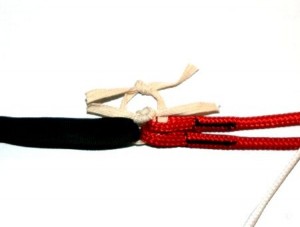
- Dynamic force is not your friend. Keep the distance between the pins and the anchor point for your staticline as short as possible to reduce snatch force. Your staticline setup has to hold the force it takes to stop your canopy after it was falling for the length of the bridle, this problem is getting bigger with the size of your canopy due to its weight.
- Check your equipment! Some parts of your equipment may wear faster than they would on freefall jumps, burn marks and abrasion on bridles, damaged PCs, etc, are quite common.

- Use a surgeons knot for the breakcords. A lot of knots can “flip” over when they are loaded, letting one side slip. If you use something different than a surgeons knot make sure this can’t happen with it.
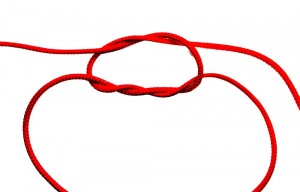
- Check your breakcord before you use it for the first time! Just to be sure that you really bought the right material, they also sent you the right material, its not damaged, etc. You could use a bathroom scale for this, attach your breakcord somewhere on your ceiling, or above a door, or …, and read off the scale how much of your weight you can put on it before it breaks.
- Test new staticline setups on a forgiving object that is freefallable. Just in case you got something wrong.
- Doubleheck every knot on your breakcords prior jumping, and do another few knots on top of the surgeons knot. As I found out those are not for aesthetic reasons, but to prevent the surgeons knot from loosening.
Long story short, I had the staticline already set up and carrying around in my pocket for some time, attached it to the railing before giving another jumper a PCA, and when I finally climbed over the railing both (!) knots went loose and the whole thing just fell off the anchor point, so I found myself already on the other side looking down at my staticline dangling together with the PC below the bridge.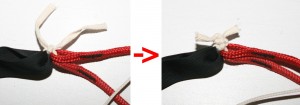
- Friction’s a bitch! Try to prevent that the staticline has to go over an edge, and use a staticline system with which friction on the anchor point does change the force required to break the breakcord.
Below is an example of such a “bad” CWY setup where one side is directly attached to the bridle and the knot on the other side. This system would release when loaded 150kg in theory (assuming that the loop itself would break at 75kg, see this post) which is quite a lot already. In real life the friction force it takes for the staticline to move over the anchor point can get rather big, big enough that the sum of all forces exceed the bridles strength, that is weakened (a lot) by the knot.
See picture aside, thanks to Andreas for permission to use the picture.
I tried to reproduce this with E-thread insted of breakcord and measured 5kg break load for the loop of E-thread, 10kg if this system is used with a carabiner as anchor point (wich adds only little friction), and more than 15kg with a climbing hold that has a rough surface. So factor 3 or even more on the breaking strenght of the loop could occur if the anchor point is rusty, has sharp edges, etc.
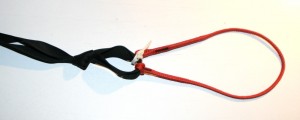
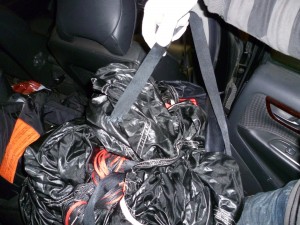
- Watch thy bridle! When the staticline is set up to the anchor point, move carefully to not pop your pins prematurely, and take care to not entangle with the bridle. Check bridle routing when you are standing on the exit and are ready to jump, and watch your feet!
http://vimeo.com/34468248
Thanks to Beslan for the video!
Leave a comment if you have something to add!